
Xylosma is a genus of flowering plants in the family Salicaceae. It contains around 100 species of evergreen shrubs and trees commonly known as brushhollies, xylosmas, or, more ambiguously, "logwoods". The generic name is derived from the Greek words ξύλον (xylon), meaning "wood, tree", and ὀσμή (osmé), meaning "smell", referring to the fragrant wood of some of the species. The Takhtajan system places it in the family Flacourtiaceae, which is considered defunct by the Angiosperm Phylogeny Group.

Pyrus pyrifolia is a species of pear tree native to southern China and northern Indochina, and have been introduced to Korea, Japan and other parts of the world. The tree's edible fruit is known by many names, including Asian pear, Persian pear, Japanese pear, Chinese pear, Korean pear, Taiwanese pear, apple pear, zodiac pear, three-halves pear, papple, naspati and sand pear. Along with cultivars of P. × bretschneideri and P. ussuriensis, the fruit is also called the nashi pear. Cultivars derived from Pyrus pyrifolia are grown throughout East Asia, and in other countries such as India, Pakistan, Nepal, Australia, New Zealand, and the United States. Traditionally in East Asia the tree's flowers are a popular symbol of early spring, and it is a common sight in gardens and the countryside.
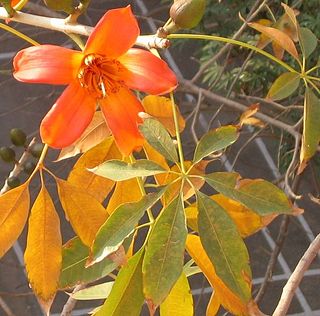
Bombax is a genus of mainly tropical trees in the mallow family. They are native to western Africa, the Indian subcontinent, Southeast Asia, and the subtropical regions of East Asia and northern Australia. It is distinguished from the genus Ceiba, which has whiter flowers.

Verbena, also known as vervain or verveine, is a genus in the family Verbenaceae. It contains about 150 species of annual and perennial herbaceous or semi-woody flowering plants. The majority of the species are native to the Americas and Asia; however, Verbena officinalis, the common vervain or common verbena, is the type species and native to Europe.

Carl Sigismund Kunth was a German botanist. He was also known as Karl Sigismund Kunth or anglicized as Charles Sigismund Kunth. He was one of the early systematic botanists who focused on studying the plants of the Americas. Kunth's notable contributions include the publication of Nova genera et species plantarum quas in peregrinatione ad plagam aequinoctialem orbis novi collegerunt Bonpland et Humboldt. This work spanned seven volumes and was published between 1815 and 1825.
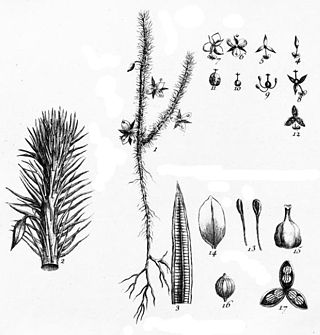
Mayaca is a genus of flowering plants, often placed in its own family, the Mayacaceae. In the APG II system of 2003, it is assigned to the order Poales in the clade commelinids. The Cronquist system, of 1981, also recognised such a family and placed it in the order Commelinales in the subclass Commelinidae.

Dichorisandra is a genus of perennial monocotyledonous flowering plants in the dayflower family (Commelinaceae). It is found in the Neotropics. The genus is characterised by its slightly zygomorphic flowers with large anthers usually releasing pollen by means of pores at the apex, as well as by its seeds that are embedded in a red or sometimes white aril, and tubers that often form at the tips of the roots. Both morphology and an analysis of DNA sequences indicate it is very closely related to the genus Siderasis.

Weinmannia is a genus of trees and shrubs in the family Cunoniaceae. It contains 90 species, which range from Mexico through Central and South America including the Caribbean, and to the Mascarene Islands in the western Indian Ocean. It is absent from mainland Africa and Australia, but some fossils have been attributed to Weinmannia in Australia.

Cleome is a genus of flowering plants in the family Cleomaceae, commonly known as spider flowers, spider plants, spider weeds, or bee plants. Previously, it had been placed in the family Capparaceae, until DNA studies found the Cleomaceae genera to be more closely related to the Brassicaceae than the Capparaceae. Cleome and clammyweed can sometimes be confused.
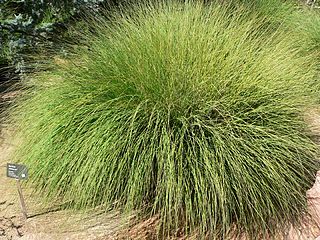
Muhlenbergia is a genus of plants in the grass family.

Cochlospermum is a genus of trees in the Bixaceae family; some classifications place this genus in the family Cochlospermaceae. It is native to tropical regions of the world, particularly Latin America, Africa, the Indian Subcontinent, and Australia.

Licania is a genus of over 200 species of trees and shrubs in the family Chrysobalanaceae. Species are found naturally occurring in Neotropical forests from southern Mexico to Brazil and the Lesser Antilles. Due to increased deforestation and loss of habitat, several species have declined, some markedly so, and L. caldasiana from Colombia appears to have gone extinct in recent years. Many species are either rare or restricted in distribution and therefore potentially threatened with future extinction.
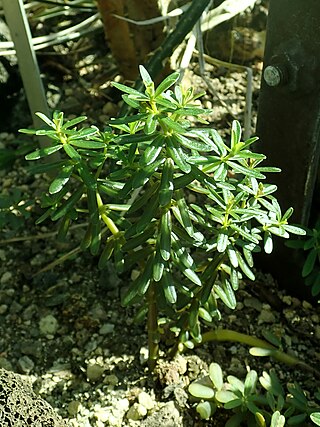
Peperomia galioides is a species of plant in the family Piperaceae, native to Mexico, Central America and South America. P. galioides has petioles of less than 1mm long and leaves between 5-30mm. There has been research in Colombia and Peru to know about the essential oils of this species. It was traditionally used in Peruvian herbal medicine.
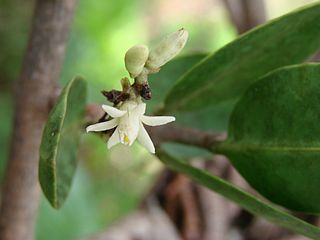
Phthirusa is a South American genus of parasitic shrubs in the family Loranthaceae.

Noisettia is a genus of flowering plants in the violet family Violaceae, with a single known species.
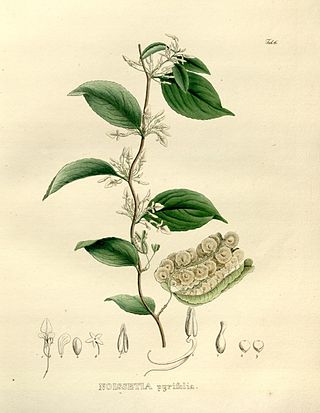
Anchietea is a genus of flowering plants in the violet family Violaceae, with six accepted species, found in tropical South America.
Morisonia is a genus of flowering plants in the family Capparaceae, found across the Americas from the United States to Argentina. It was recently enlarged with New World Capparis species due to existing taxonomic instability. They tend to be shrubs or small trees.
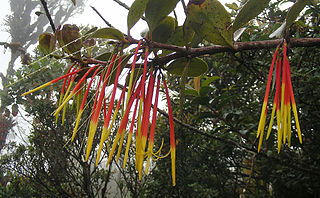
Aetanthus is a genus of flowering plants belonging to the family Loranthaceae.

Passovia is a genus of flowering plants belonging to the family Loranthaceae.
Oryctanthus is a genus of flowering plants belonging to the family Loranthaceae.
















